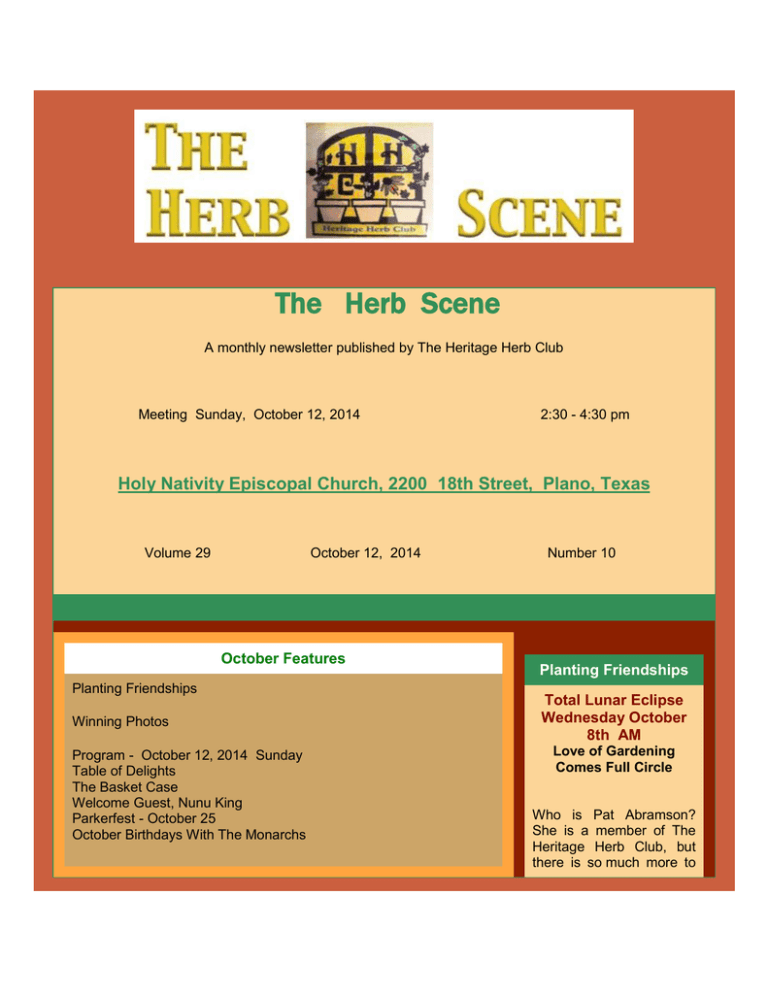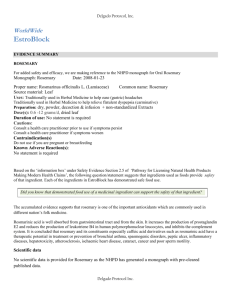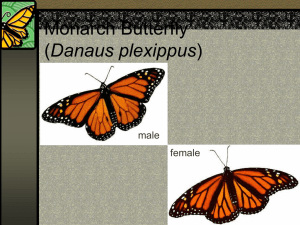
The Herb Scene
A monthly newsletter published by The Heritage Herb Club
Meeting Sunday, October 12, 2014
2:30 - 4:30 pm
Holy Nativity Episcopal Church, 2200 18th Street, Plano, Texas
Volume 29
October 12, 2014
October Features
Planting Friendships
Winning Photos
Program - October 12, 2014 Sunday
Table of Delights
The Basket Case
Welcome Guest, Nunu King
Parkerfest - October 25
October Birthdays With The Monarchs
Number 10
Planting Friendships
Total Lunar Eclipse
Wednesday October
8th AM
Love of Gardening
Comes Full Circle
Who is Pat Abramson?
She is a member of The
Heritage Herb Club, but
there is so much more to
From The President
learn about her. While
researching her on the
internet, I was surprised
how intertwined our lives
are. Mine is serendipitous,
but I am always surprised
at the many reactions
that respond from
one
simple action.
Recipes From Pat Abramson
Fig Cookie Recipe From John Azevedo
Monarchs & Milkweed
Is It A Monarch Or A Viceroy?
And The Winners
Of September's
Photo Contest Are
1st Place
Pickled Pantry
Elaine Brandt
3rd Place
2nd Place
Windowsill
Geraniums
Edee Hanson
Flamingo Creek
Gladys Denham
The Love Of A Child
Comes Full Circle
A few years ago, Pat had
an idea that took fire
starting in Greenville,
Texas, which she took to
Fort
Worth. Her
idea ended up in Haiti,
returning back to Pat. She
had her junior gardening
students send greeting
cards to orphaned children
in Haiti. The Haitian
children were thrilled!
Some children responded
back with cards. This
simple act had a gigantic
effect that will reverberate
positively
for
years.
Opportunity is always in
front of us, waiting for us to
see it. I'm looking forward
to hearing what she has to
say, aren't you?
Herb: Hops (Humerlus
Lupulus)
Stone: Opal, Tourmaline
- Nancy J Seaberg,
Newsletter Editor
October Program
Preserving The Harvest
With
Herbal Vinegars
Join us on Sunday,
October 14, for a special
program; Preserving the
Harvest
with Herbal Vinegars, with
our
very
own
Pat
Abramson.
4th Place
Beautiful Fig
John Azevedo
5th Place
Spider - Mosquito Monster
Marita Strange
October Program
Preserving The Harvest With Herbal Vinegars
Autumn Is Trying To Arrive
In addition to bringing lots
of samples of food and
craft ideas she creates
from her fall garden
harvest, Pat will be guiding
us as we each make herbal
vinegar to take home and
enjoy. The Club will be
providing the bottles, white
vinegar,
and
pretty
material to decorate bottle
tops. For more than one
bottle of vinegar to take
home, feel free to bring
additional bottles and
additional
vinegar
for
yourself, or your other
favorite vinegar types though the clear vinegar
allows you to better
appreciate your culinary
"work of art."
What You Can Bring
We
need
several
volunteers to bring in a
supply
of
organic rosemary
cuttings. Other organic
herbs, if you'd like to bring
some for yourself or
others,
might
include
Mexican mint marigold ,
tarragon, lavender stalks,
edible
flowers,
garlic
blossoms,
dill
weed,
etc. Peppercorns, garlic
cloves, dried chili peppers
(or fresh, if split in half
lengthwise), and spice
seeds might also make
your creation more exotic,
though not necessary, as
your rosemary vinegar will
be quite lovely!
Will You Join Us In Welcoming Autumn?
Combinations to consider:
dill, garlic & peppercorns;
anise, caraway, celery,
cumin, coriander, mustard
seeds with dill and/or
fennel (delicious, believe it
or not!). Or, allspice,
cloves,
and/or
mace
seeds, peppercorns, a
small cinnamon stick,
garlic, dried chiles and
fresh peels of organic
orange, lemon or lime rind
in addition to the fresh
herbs used.
Show Your Stuff!
You are invited to bring any
samples of crafts or
canned items that you've
made from your herb
harvest! A separate table
will be available to feature
these samples for display.
Have You Ever Seen
So Many Pumpkins In Texas?
Please email Marie if you
are
willing
to
bring
some rosemary for the
group,
tottenmp@gmail.com.
The bottles that we will be
using will accommodate
two or three rosemary
stalks that are only about
5" long. Longer stalks
should go a long way,
since we can cut them into
several shorter pieces.
About Pat Abramson
In addition to growing
vegetables and flowers,
Pat Abramson is the Herbs
Instructor
for
annual
Master Gardener training
classes
in
Hunt
County. She grows over
one hundred herbs.
Pat moved to the country
fifteen years ago and is still
in the "honeymoon phase"
of country living. She and
her
husband
began
growing organically, using
only square-foot beds. Pat
has learned to hand-grind
wheat to bake bread, tends
to go overboard "canning,"
and makes wine from fruits
and even vegetables. Pat's
garden is her "outdoor
experiment station," where
she likes to grow unusual
plants such as peanuts,
horseradish, and cardoon.
Join us on Sunday,
October 12 for this special
program.
Marie Totten, Vice
President - Programs
Table of Delights
So Many Ways To Make Herbal Vinegars
October is coming up with
cooler weather, I hope.
Pumpkin faces, goblins,
ghosts, witches and
ghouley creatures
abound. I thank all of
those participating in set
up and clean up. There
Table of Delights
have been many willing
hands to change chairs
and tables to fit the
needed formation for the
program. Also, for your
wonderful dishes on the
table of delights! Perhaps
this month your herbal
treat can be transformed
into something scary!
Witches will be flying
around and probably land
on the table to scare you
too! Perhaps you would
like to add to the
atmosphere by wearing a
costume. You can practice
for the real event.
Volunteers Wanted At
See you there!
The Table Of Delights
Elaine Taylor, Vice
President - Hospitality
The Basket Case
The Basket Case
Have you ever wished you
had a fairy godmother? If
you wish very hard....AND
buy some raffle tickets, you
could
win
one
this
month! Still in its original
box, one of the raffle prizes
is a collectible fairy
godmother designed by
Jacqueline Kent. Another
collectible, a black and
white
porcelain
plate
decorated with a rosemary
plant, is also offered as a
raffle.
What new surprise to win this month.
Mary Jones is signed up
for the October food
raffle. It is not known at
this time what Mary will
bring, but we are certain it
Be A Winner -- Buy A Raffle Ticket!
Welcome Our Guest & 2X Raffle Winner
Please Welcome Our Guest - Nunu King
Volunteer At ParkerFest -- September 25
HHC Booth, ParkerFest
October 25, 2014 Saturday
will be a delightful treat,
as always. Mary started
the idea of food raffles
several years ago, by
bringing one her favorite
recipes to a meeting, and
suggesting that we should
raffle it. I will never forget
that pecan pie! No, I did
not win it, but It brought in
a lot of money! We have
continued the tradition,
and our food raffles have
been very successful in
helping to raise funds to
help pay the rent. Thank
you Mary
Jones,
and
everyone
who
participates. If you would
like to bring a food raffle
item, please let me know.
Our guests are always
lucky winners! Nu Nu King
won two raffles! She won
the lotion bar, donated by
Kim Wright as a surprise
raffle. When she won
again, Nu Nu chose the
book,
THE
HERBAL
PANTRY. Another guest,
Wanda Mansken, the
mother of our speaker The
Honey Queen, won the fig
cookies donated by John
Azevedo. We hope our
guests visit
us
again
soon. There were four
other
raffle
winners: Nancy Seaberg,
Elaine Taylor, and Marie
Totten. They won wall
hanging
vases
with
herbs. Gladys Denham
also had a winning
ticket, but passed to give
someone else a chance to
win.
Happy October Birthdays!
The September raffle
earnings
were
$48.00. Thank you to all
who
participated.
HAPPY AUTUMN!
Gladys Denham, Ways
and Means
Parkerfest - Funday
October 25, 2014
Saturday
10 am -- 4 pm
Monarch is emerging to share its
October birthday with you.
Parkerfest is October
25 2014, Saturday, from
10:00 am until 4:00 pm.
The Heritage Herb Club
is having a booth there
to attract
new
members. To join in the
fun and to volunteer at
the
booth, contact
Elaine Brandt.
More Recipes From Pat Abramson
Elaine Brandt, Secretary
From The President
Herbal Vinegars
Happy
Autumn,
everyone! My favorite
time of year has finally
arrived in the form of
cool evenings, gentle
breezes and pumpkins
everywhere. This is the
time of year for reaping
the second harvest from
our gardens, whether it
be vegetables, fruit or
herbs.
For
making
tinctures, teas and tonics
to carry us through the
Hibiscus Tea
TEXAS SALSA
12 lbs. tomatoes
7 garlic cloves
15 jalapenos (remove seeds)
1 bundle (supermarket size) cilantro
4 onions
1 c vinegar
½ c lemon juice
1 t salt
12 oz. tomato paste
Optional: green peppers, banana peppers, sugar.
Remove skin from tomatoes. Chop all in food processor or
blender. Toss all in big pot and add lemon juice, vinegar, salt
& tomato paste. Bring to a boil. Simmer 5 minutes. Portion
out in jars a& process for 45 minutes in boiling water
bat. Makes about 12 pints.
cold winter months. For
canning or freezing our
fresh produce to ensure
a healthy nourishing
meal when it's cold and
dreary outside.
For
cozying up beside a fire
with a good book and
something warm to sip.
Fall intoxicates me with
its colors and scents.
Speaking of scents, I'm
a huge incense burner. I
just love the smells of
nature. I'm not talking
about
those
awful
smelling sticks you might
purchase
from
the
discount
store.
I'm
talking about the actual
burning
of
resins,
woods, roots, barks,
petals, leaves and dried
fruits. It's quite easy; and
once you've created and
burned
your
own
incense, you'll look at
how you "scent" your
home a whole different
way!
To get started, you'll
need
your
incense
ingredients, a mortar
and pestle or an electric
grinder, a non-metal
bowl, a wooden spoon,
charcoal rounds, sand,
and
a
heat-proof
container. All of these
ingredients
can
be
purchased online at
Mountain
Rose
Herbs. Make sure your
Parmesan Twisters
ALICIA WEINSTEIN'S
ROSEMARY PARMESAN TWISTS
1 sheet (from 17.25 oz. pkg) frozen puff pastry thawed, 1 egg, 1
T water, ¼ c shredded Parmesan, 1 ½ T chopped fresh
rosemary (or 1 t dried), ½ t coarsely ground black pepper.
Preheat oven to 400 degrees. Line 2 baking sheets with
parchment paper. Roll puff pastry into a 10 x 14"
rectangle. Whisk egg and water together; then, brush on
pastry. Sprinkle with Parmesan cheese, rosemary, and pepper.
Press lightly into pastry with your fingers. Cut pastry into 24
strips, each slightly more than ½" wide. Twist each strip and
place on baking sheets. Bake 10 - 12 minutes until
golden. Serve warm or at room temp. Serves 12.
Tip: Double the recipe, and freeze second batch, unbaked, on
cookie sheets. Seal in plastic bag, and keep frozen up to a
month. Bake frozen twists 10 - 15 minutes until golden.
Cuccidata Sicilian Fig Cookie Recipe
incense ingredients are
dry and using a mortal
and pestle or electric
grinder, grind them to
the consistency of salt or
sand. This will take
some practice; and
remember to pulse. You
don't want to burn up
your
grinder.
Place
ingredients in a bowl and
stir. You will always want
to have a resin or gum
as
one
of
the
ingredients, as these are
sticky and help to bind
everything together. Put
a layer of sand in the
bottom of a heat-proof
container.
Using
scissors
or
kitchen
tongs, hold the charcoal
round up, and light, it will
crackle, sputter and
spark! Once it quits the
theatrics, place on the
sand. Add a teaspoon of
your incense on top of
the charcoal. It will
smolder depending on
the ingredients you
used The Internet is full
of recipes, but you
can use what you like,
Once the smoke dies
down,
add
another
teaspoon of incense on
top
of
what
was
previously burned. For a
true Autumnal smell, use
any of the following
incense
ingredients:
cinnamon,
cloves,
dragons blood resin,
Thanks to John Azevedo for sharing!
Delicio!
Sandra Scalise Juneau's
Recipes & More
Recipes From
Cuccidata Sicilian Fig Cookies
Pat Abramson
FIG FILLLING
Ingredients for 2 pounds fig filling:
2 pounds dried Greek figs
1 tbsp cinnamon
4 tbsps honey
2 tbsps orange zest
pinch black pepper (1/8 tsp)
Ingredients for 10 pounds fig filling:
dried
orange
peel,
rosemary,
sage,
sandalwood, dried oak
leaf or oak moss. Enjoy!
10 pounds dried Greek figs
5 tbsps cinnamon
1 cup honey
½ cup orange zest
¾ teaspoon black pepper
Method:
Remove stems from figs. Rinse thoroughly in warm water to
soften. Drain off any excess water. Set aside.
Season figs with cinnamon, mixing thoroughly. Coat with honey
then blend in orange zest and black pepper. Grind fig mixture
to a fine ground texture using an electric meat grinder (not a
food processor).
After mixture is ground, mix thoroughly to blend all ingredients.
Separate into 1 or 2-pound packages wrapped in plastic food
wrap and sealed in plastic bags. This mixture will keep in
October is Harvest
Time! The following
recipes for using and
preserving come from
our October speaker,
Pat Abramson.
Enjoy Your Herbal
Harvest
Rosemary Room Mist
15 fresh rosemary
sprigs
8 oz glass jar w/screwtop
8 oz isopropyl alcohol
5" square cheese cloth
16 oz plastic spray bottle
w/pump-handle
screw-top
8 oz. distilled water.
Rinse rosemary under
cold water, pat dry. In
glass
jar,
combine
rosemary & alcohol. Set
aside in cool, dark place
for 2 weeks. Agitate jar
once a day. Place
cheese cloth in finegauge sieve.
Strain
tincture
into
spray
bottle. Discard spent
herb.
Add
distilled
water. Shake gently
refrigerator for several weeks, or it may be frozen for up to 6
months.
CUCCIDATA DOUGH
Ingredients for large fig cake designs:
5 pounds plain flour
1 cup white vegetable shortening
1 cup granulated sugar
2-3 cups warm water (gradually add as needed to form
a moist dough)
Ingredients for small fig cakes:
5 cups plain flour
¾ cup white vegetable shortening
¾ cup sugar
1-2 cups warm water (gradually add as needed to form
a moist dough)
Method:
In a food processor (or by hand), blend flour and shortening to
a cornmeal texture. Set aside.
Dissolve sugar in warm (tepid, not boiling) water. Gradually
add sugar/water to flour mixture and blend until dough forms a
ball. If dough is too dry, gradually add more water as needed.
Cover, set aside and allow the dough to rest for 10 minutes.
Separate dough into workable sized balls (for large cakes,
about 6 inches across, for individual cookies, about 3 inches
across). Knead each ball to a smooth texture and return to
bowl. Cover again, then allow dough to rest for several more
minutes.
ASSEMBLY
before each use. Spray
the air for a forest-fresh
scent. Store in cool,
dark place. Stays fresh
for months. Makes 16
ounces.
Herbal Bath Salts
Recipe #1: Combine
Epsom salts, chopped
dried herb leaves and
rose
petals
in
an attractive
glass
jar. Add a bow and use
a seashell as a scoop,
along with instructions to
rub a tablespoon onto
the skin after a bath or
shower and rinse.
Recipe #2: For each
cup of sea salt or plain
salt, use ten drops of
coriander or another
essential oil such as
peppermint
(invigorating), lavender
(soothing & invigorating)
or rose oil.
Recipe #3:
Thrust
stalks of fresh spearmint
into tall, wide jars and
fully cover with alt. Wait
two weeks, then remove
stalks, chop spearmint
leaves, and mix with
salt.
You can add
chopped rose petals for
color. As an option, you
can
add
one
to
two drops of essential
oils. such as mint or
Ingredients:
rose. Attach instructions
for use.
Prepared fig filling
Prepared dough balls
Method:
Preheat oven to 250°F. Roll a small piece of dough (about a 2inch ball) into the thickness of pie pastry. Cut into 4" x 12"
strips. Shape fig filling into ½-inch wide rolls. Fill center of
dough with fig mixture.
Fold sides of pastry over figs, overlapping dough slightly. Turn
over, seam side down, and pat lightly to flatten.
Cut on an angle into 1-inch long bars. Cut slits in sides and on
top to allow filling to cook through. Bake at 250°F 20-30
minutes. Cookies should be slightly browned on the bottom
only.
Allow to cool before icing cookies.
CUCCIDATA ICING
Ingredients for icing:
1 tbsp milk
2 drops almond extract
2 cups powdered sugar
colored nonpareils (sugar sprinkles)
Method:
Combine milk and almond then gradually blend in sugar,
mixing to a smooth paste. Icing should be the texture of heavy
cream.
Thoroughly cool cuccidatae (cookies) before icing. Working over
a small bowl, spoon icing onto each cookie, allowing excess to
drip into the bowl.
Herbal Bath Tea. Stir ¼
lb. of each of these dried
herbs:
chamomile,
orange peel, lavender,
sea salt or Epsom
salts. Scoop about ¼ of
a cup into a muslin bag
and steep in your bath.
(Alternate
herb
combinations: lavender,
basil, rosemary, sage.)
Herbal
Bath
Soak. Combine
oatmeal,
cornmeal,
dried
rosemary,
lavender, baking soda,
and powdered milk and
place in a muslin bag
(stamped and colored
optional) for use in the
bath.
Herbal Honey
Lavender Honey I: For
each cup of honey, use
¼ cup dried-lavender
flowers
(or
other
herbs). Heat honey in
double boiler, preferably
on very low heat . Do not
boil.
Add lavender,
continue cooking and
stirring
for
five minutes. Strain.
Lavender
Honey II:
Combine
one 8 oz cup of honey
with 1 T dried lavender
flowers, 2 fresh rosescented
geranium
Allow each cookie to dry slightly before sprinkling with colored
nonpareils. Before packaging cookies, allow them to dry
completely (if they last that long !).
Monarchs Feasting On Butterfly Weed
Monarch larvae appear to feed exclusively on milkweeds in the
genus Asclepias and several other genera of viny milkweeds in
North America. Milkweeds are perennial plants, which means an
individual plant lives for more than one year, growing each
spring from rootstock and seeds rather than seeds alone. In the
Midwest, milkweeds were historically common and widespread
on prairies, but habitat destruction has reduced their range and
numbers.
Milkweeds belong to the family Asclepiadaceae, derived from
Asklepios, the Greek god of medicine and healing. Though most
members of the genus Asclepias are tropical, there are
approximately 110 species in North America known for their
milky sap or latex contained in the leaves. Most species are toxic
to vertebrate herbivores if ingested due to the cardenolide
alkaloids contained in the leaves and stems. When Monarch
larvae ingest milkweed, they also ingest the plants' toxins, called
cardiac glycosides. They sequester these compounds in their
wings and exoskeletons, making the larvae and adults toxic to
many potential predators. Vertebrate predators may avoid
Monarchs because they learn that the larvae and adults taste
bad and/or make them vomit. There is considerable variation in
the amount of toxins in different species of plants. Some
northern species of milkweed contain almost no toxins while
others seem to contain so much of the toxins that they are lethal
even to monarch caterpillars.
leaves. Optional: 5 fresh
orange mint leaves
(optional). Follow per
above.
Lemon
Verbena
Honey: 1 c honey, 1
sprig or several leaves of
fresh
lemon
verbena. Follow above,
but let it sit for a one
week or more, then
strain.
Herbal Vinegars
Rosemary
Wine
Vinegar: 1 quart redwine
vinegar
and a
handful of rosemary
sprigs Crush rosemary
lightly
to
release
fragrance. Heat vinegar
in a non-aluminum pot 8
- 10 minutes, on medium
(do not boil). Pour. Add
rosemary.
Set
2
weeks. Strain.
Dill Garlic Vinegar: 3
cups cider vinegar, 8 12 sprigs fresh dill (or 2
T crushed seeds) 1
clove
garlic,
sliced
(optional),
10
peppercorns.
Wash
dill& put in jar. Add other
ingredients. Fill with
WARM vinegar (follow
above instructions) to
cover. Set in cool dark
place & shake 3 times
daily for 3 to 4 weeks.
Taste, strain, add a sprig
of fresh dill, and keep in
a decorative container.
Floral Structure. Flowers are significant in plant identification
because flowers are intricate structures with many features that
can be assessed, counted, and measured. Affinities among
closely related species can be shown because floral morphology
is conservative. Leaves and stems have features shared across
many groups and lack unique combinations of features for
species identification.
Like other flowers, milkweeds have floral whorls of sepals
(collectively referred to as the calyx) and petals (collectively
called the corona). Flowers of milkweeds are interesting
because they have an third whorl of five hoods each of which
encloses a horn (modified filaments of the anthers). Together,
hoods and horns are referred to as the corona. The horns of
some species are long, while the horns of others are reduced to
the point they cannot be seen.
Pollination. Milkweeds have a unique and fascinating
pollination mechanism in which the plant relies on Lepidoptera
(butterflies and moths) and Hymenoptera (bees, ants, and
wasps) for pollination. Hundreds of pollen grains are packaged
into two connected sacs or pollinia, which is collectively referred
to as the pollinarium [see SEM photo at right]. When a foraging
insect lands on a flower, the pollinarium can easily attach itself
to its leg. Once removed from the flower, the pollinia actually reorient as the translator arms bend as they dry. Upon landing on
another flower, the properly oriented pollinarium is deposited
into a receptive stigmatic groove where the pollinia breaks down
and the pollen germinates, growing pollen tubes through the
stigma to the ovules in the ovary.
The milkweed fruit is a follicle, commonly referred to as a pod,
which splits at one suture to release many seeds, sometimes
hundreds, depending on the species.
Herbal
Kitchen
Vinegar: Use 1 or
2 tablespoons of each
of these seeds: anise,
caraway, celery, cumin,
coriander, dill, fennel or
mustard.
Then add
1 tablespoon of allspice,
cloves,
mace,
peppercorns,
small
cinnamon stick, 3 - 4
peeled garlic cloves and
2 dried chili peppers (or
fresh, if you split in half
lengthwise. Add fresh
peels of organic orange,
lemon or lime rind (use
vegetable peeler). Add
a few sprigs of any fresh
herb, so that the rind
doesn't sink; then, coax
strips into bottle using
wooden skewer. Add
vinegar
at
room
temperature (red or
white wine vinegar, rice,
cider or other fruit
vinegar. Return next
day to top off bottle. Let
stand overnight before
using. Refill your herb
vinegar
bottle
the
equivalent
of
3
times. You will know
they are spent when
they begin disintegrating
& their level will be
reduced by half.
Herbal Tea
Rose Petal And Lemon
Verbena Tea: In a large
bowl, toss equal parts of
dried organic rose petals
and
freshly-picked
lemon-verbena leaves
with
gunpowder
tea. Package in clear jar
and label with brewing
instructions. This
is
ready
to
give
immediately
after
blending, but improves
with storage.
Hibiscus Tea: 4 c
water, ½ c dried hibiscus
flowers, honey to taste, 3
c cold water, 1 lime thinly
sliced.
*Note:
Hibiscus
will
stain
teapot,
countertops,
everything.
So Many Ideas, So Many Choices
Mortar & Pestle
for grinding herbs and seeds
Harvested Herbal Vinegar
Blackberry Iced Tea
Monarch Or Viceroy
By Gladys Denham
Is that scintillating orange butterfly glinting in the sun a Monarch
or a Viceroy? Both butterflies are similar, which is sometimes
confusing. They both have orange wings with black markings;
although, the Viceroy is somewhat smaller than the Monarch. To
add to the confusion, the male Monarch appears to be a more
brilliant orange than the female, because the veins on his wings
are thinner. He also has a black dot in the center of each hind
wing, which is the scent pouch that releases pheromones to
attract the female.
The Monarch (Danaus plexippus) got its name from its green
chrysalis studded with gold dots. Golden dots merging into a line
at the top of the chrysalis reminded the American colonists of
the gold crown of a king or monarch. The Viceroy (Limenitis
archippus) does not have such regal beginnings. Its chrysalis
resembles bird droppings! Fortunately, it was not named for
those!
The Monarch and the Viceroy both have several distinguishing
traits. The sovereign Monarch alights gently, shyly holding its
wings together. The less reticent Viceroy rests with its wings
partially open. Flittering and gliding, the Viceroy can be
recognized by its erratic flight. The Monarch's more deliberate
flight pattern may be needed to conserve energy for its
treacherous migration to Mexico, which is unique among
butterflies. While the regal Monarch is selective and prefers
milkweed, the Viceroy is not so particular. It will land not only on
blooms, but also on dung, sap, rotting wood, and fermenting
fruit.
Mimicking the Monarch ,the Viceroy is "the great imposter". The
Monarch is toxic and is avoided by its potential enemies. Is the
Viceroy protected from predators merely because of its
appearance, or does it taste terrible? It is not known whether
anyone has ever actually tasted either butterfly!
Although the Viceroy is similar to a Monarch, it can be
recognized by its black "racing stripe," if you can get it to hold
still long enough to be able to see it. There is a thin, horizontal
black line, which passes through the veins on the lower portion
of its hind wings and runs parallel to the hind wing margin.
Nathaniel Hawthorne said it best. "Happiness is a butterfly,
which when pursued, is always just beyond your grasp, but
which, if you will sit down quietly, may alight upon you."
Which is the Monarch? Which is the Viceroy?
11424 County Road, Princeton, Texas 75407 ----- 469-247-9066
Copyright © 2014. All Rights Reserved.
Forward this email
This email was sent to taylor_hv@hotmail.com by texasherblady@yahoo.com |
Update Profile/Email Address | Rapid removal with SafeUnsubscribe™ | Privacy Policy.
The Heritage Herb Club | Meetings: 2200 18th Street, Plano, Texas | Mailing Address: 3313 Lynbrook Drive,
Plano, Texas 75075 | Plano, Texas | TX | 75075








